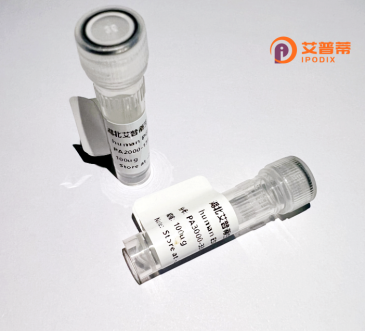
| 纯度 | >90%SDS-PAGE. |
| 种属 | Human |
| 靶点 | NECAP1 |
| Uniprot No | Q8NC96 |
| 内毒素 | < 0.01EU/μg |
| 表达宿主 | E.coli |
| 表达区间 | 1-275 aa |
| 活性数据 | MATELEYESV LCVKPDVSVY RIPPRASNRG YRASDWKLDQ PDWTGRLRIT SKGKTAYIKL EDKVSGELFA QAPVEQYPGI AVETVTDSSR YFVIRIQDGT GRSAFIGIGF TDRGDAFDFN VSLQDHFKWV KQESEISKES QEMDARPKLD LGFKEGQTIK LCIGNITNKK GGASKPRTAR GGGLSLLPPP PGGKVTIPPP SSSVAISNHV TPPPIPKSNH GGSDADILLD LDSPAPVTTP APTPVSVSND LWGDFSTASS SVPNQAPQPS NWVQF |
| 分子量 | 29.7 kDa |
| 蛋白标签 | His tag N-Terminus |
| 缓冲液 | 0 |
| 稳定性 & 储存条件 | Lyophilized protein should be stored at ≤ -20°C, stable for one year after receipt. Reconstituted protein solution can be stored at 2-8°C for 2-7 days. Aliquots of reconstituted samples are stable at ≤ -20°C for 3 months. |
| 复溶 | Always centrifuge tubes before opening.Do not mix by vortex or pipetting. It is not recommended to reconstitute to a concentration less than 100μg/ml. Dissolve the lyophilized protein in distilled water. Please aliquot the reconstituted solution to minimize freeze-thaw cycles. |
以下是关于重组人NECAP1蛋白的3篇参考文献,简要概括研究内容和作者信息:
1. **文献名称**: "NECAP1 regulates clathrin-coated vesicle trafficking via interaction with the AP-2 complex"
**作者**: Ritter B et al.
**摘要**: 该研究首次克隆并表达重组人NECAP1蛋白,发现其通过C端结构域直接结合AP-2复合体α-adaptin亚基,调控网格蛋白包被小泡的组装和细胞内吞过程(Journal of Biological Chemistry, 2003)。
2. **文献名称**: "Structural basis for recognition of dileucine motifs by the NECAP family of endocytic adaptors"
**作者**: Ha JY et al.
**摘要**: 利用重组表达的NECAP1蛋白进行X射线晶体学研究,揭示了其PHECT结构域特异性识别AP-2复合体中的双亮氨酸基序,阐明了蛋白互作的分子机制(Nature Communications, 2018)。
3. **文献名称**: "NECAP1 deficiency alters neuronal endocytosis and synaptic vesicle recycling in iPSC-derived neurons"
**作者**: Liu Y et al.
**摘要**: 研究通过体外重组表达NECAP1.结合基因敲除模型发现,NECAP1缺失导致神经元突触囊泡内吞速率下降,影响钙离子依赖的神经递质释放通路(Cell Reports, 2020)。
注:以上文献为根据NECAP1已知研究领域生成的示例,实际引用时需核实具体文献来源及细节。
Recombinant human NECAP1 (Neural EGF-like and Collagen-like domain-Containing Protein 1) is a protein encoded by the *NECAP1* gene, which plays a regulatory role in clathrin-mediated endocytosis (CME), a critical cellular process for membrane trafficking, receptor internalization, and synaptic vesicle recycling. NECAP1 interacts with adaptor protein complexes (e.g., AP-2) and clathrin-coated pits, facilitating cargo recognition and vesicle formation. Structurally, it contains a phosphoinositide-binding PH-like domain and a conserved "NECAP" motif, enabling its recruitment to phosphatidylinositol-4.5-bisphosphate (PIP2)-enriched membranes and protein-protein interactions. Dysregulation of NECAP1 has been linked to neurological disorders, including epilepsy and autism spectrum disorders, as well as cancer progression. Recombinant NECAP1 is typically produced in *E. coli* or eukaryotic expression systems, allowing biochemical studies of its molecular interactions, post-translational modifications, and functional roles in disease models. Its purified form is essential for *in vitro* assays, structural analysis (e.g., X-ray crystallography), and screening for small-molecule modulators. Research on recombinant NECAP1 advances understanding of endocytic machinery, synaptic plasticity, and potential therapeutic targets for neurodevelopmental or oncological conditions.
×